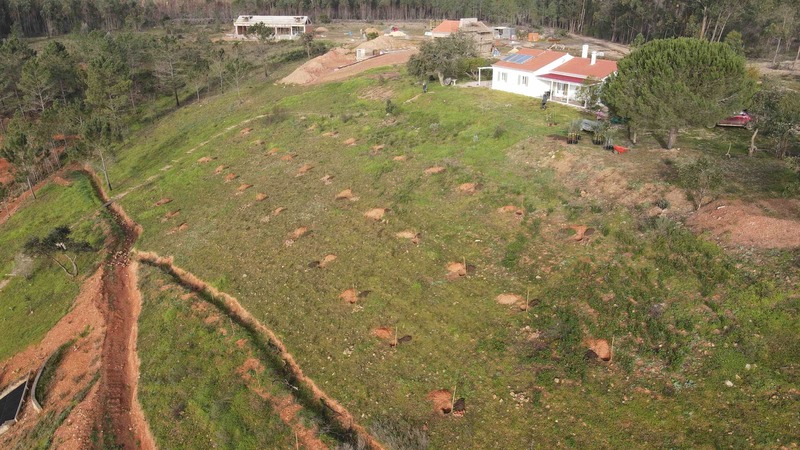
Despite the occasional touch of morning frost down in the valley, the sound of a cuckoo’s call can confirm Spring has officially sprung in our part of southern Portugal. After a fabulously rainy December gave our lake a welcome boost and our land a suitable soaking, a few weeks of cold sent me scutting for the woodpile to keep the house hot and the water warm.
But we’ve also been trying to get ahead this year by pruning our grape vines in good time, sewing oats in some of our newly-landscaped land and planting trees on our hillsides. There’s a law here that says all land within 50m of a building needs to be cleared of weeds ahead of the summer to protect from fire, but I’ll be starting the Spring clean strimming in a few weeks… to prevent having to do it twice.
While we still hold out hope for a downpour to take the lake to overflowing, the warmer weather has returned and with it the opportunity for an occasional trip to the beach to recharge our batteries. And they are in need of recharging. The natural gym is testing or backs and burning our arms as we’re digging in clay with shovels and medieval-looking throwing spikes, breaking twigs into the holes and then loading up with mature manure gifted by a local farmer.
The first challenge was Operation Olive Grove – planting 42 young trees on our steeply sloping, rocky hillside which doesn’t have much use other than hosting some solar panels and needing some heavy strimming to conform to our legal safety requirements.
We were recommended a fantastic plant nursery up in the mountains of Monchique and started off by buying five different varieties of oliveiras, or olive trees, to give us a mixture of olives to brine and eat, and those to press for oil…as long as the saplings survive.
We’ll need irrigation for the first few years to help them get through the summers, so we’re currently studying systems and planning to plug some new pipes into our pump and use some of our hard-gained lake reserves.
After last year’s grape vine massacre when I cut too hard and too late and they lost energy bleeding sap, I managed to trim our table grapes before they had awoken from their winter hibernation and didn’t get too carried away with the pruning.
They seem to like tough trimming treatment and we had a good crop last year, despite everything, but maybe there’ll be even more and even sweeter grapes this time around.
Trying something new by living off-grid in nature has a learning curve measured by seasons rather than the daily deadlines I was once used to as a BBC foreign correspondent.
We’re lucky to have this chance to follow the flow of the plants and insects, watch each day as the hillsides come alive and the layers of colour emerge from the blanket of green.
But there’s a short planting window to give trees and shrubs the best chance of success.
We’ve now moved on to Operation Hoover Dam to put new blisters on top of our olive grove-planting old blisters.
Late last year we brought in a bulldozer for a bit of extreme gardening: shoring up our dam and turning three and a half semi-collapsed terraces into one large new one.
Wide areas were left covered in clay, which takes a lot longer to seed and it’s still somewhat bare despite our best efforts with a few sacks of oats – hence our neighbour Daniel’s description of our new levee looking like the Hoover Dam from his house.
We’ve been softening its look by cutting paths and using the shelter from the prevailing sea breeze and a slightly lower aspect to plant pomegranate and fig trees, nespras (lowquat or Japanese plum), marmelos (quince) and a couple of soon to be acquired avocado trees.
It’s tough but rewarding work and with just a dozen or so mixed citrus trees, a mulberry and four plum trees to go, we’re hoping to wrap up the planting phase and crack on with the cleaning.
With the addition of some sacks of flower and grass seeds we will spruce up the valley now and for years to some. There’s always plenty to do in the countryside, but hopefully it’s keeping our hearts healthy and we’ll be literally harvesting the fruits of our labour in the not too distant near future.
